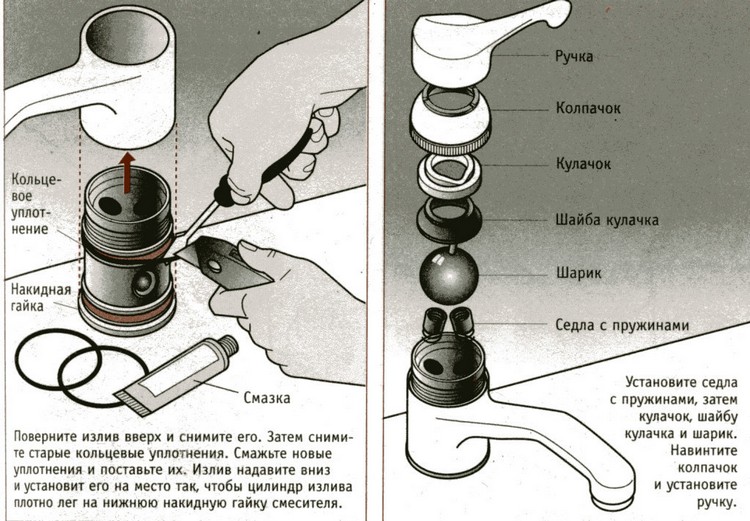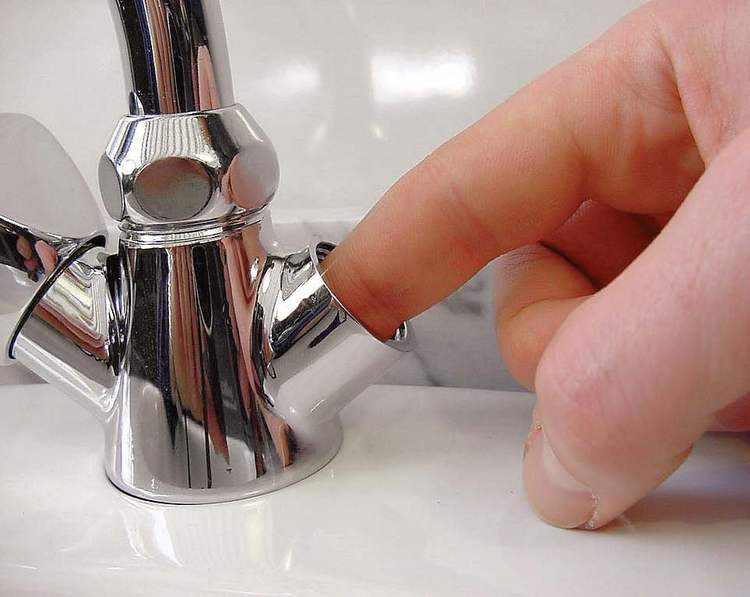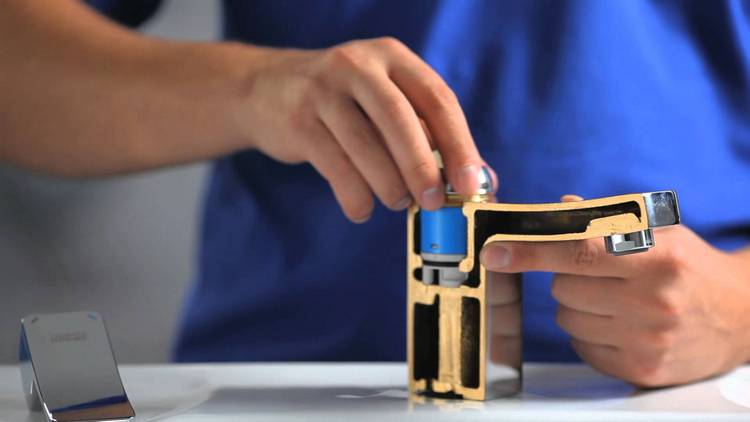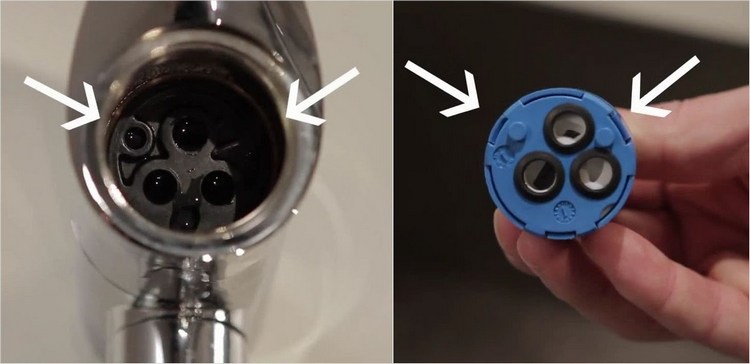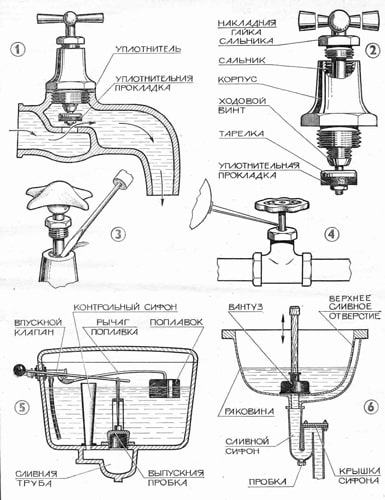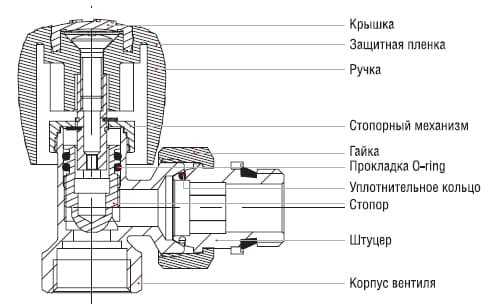Repair of a single-lever mixer with a ball block
Problems with a single-lever ball faucet are usually caused by a broken valve mechanism. The lever, fixed with a screw, is removed in the same way as in the case of a cartridge faucet. The domed metal cap, which is located below, fixes the entire valve mechanism in the body. Under the cap is a plastic cam that limits the movement of the control lever. At the bottom of the cam is a dome-shaped washer for a snug fit to the mixer ball. The device of the ball and the principle of mixing, we have already described above.
Disassembly order
- Remove the plastic red and blue pads and unscrew the lever as described above. The difference will be that the pin from which you want to twist the lever is not polymer and rectangular, but metal, with a thread for the screw fixing the lever.
- Unscrew the domed cap. It can be equipped with slots for a comfortable grip. But if there is no slot, use a screwdriver: rest it in the groove and gently knock it up and clockwise, tearing the part from its place. You can also use round nose pliers by inserting them into the grooves from inside the cap.
- After removing the cap, remove the cam with a figured washer. Clean them off with a rag.
- Take out the mixer ball and examine its valve part.
- Remove valve seats. They are easily removed with a thin screwdriver. With tweezers or a screwdriver, you can get the clamping springs under the saddles.
Typical Ball Mixer Valve Gear Problems
Leaks or excessive noise can be caused by the following problems:
- The inside of the dome washer or the seat in the body where the bottom of the ball rests is worn or heavily soiled. These spherical cavities must be thoroughly cleaned.
- Ball wear. It may show cracks, grooves. All this is caused by dirty and hard water with impurities of solid particles. The only way to fix it is to replace the ball.
- Valve seat wear. If they start to fit poorly on the ball, then they let water through. They also need to be replaced.
- Poor seat fit can be caused not only by worn seats, but also by loose springs. The problem is solved by replacing the springs with new ones.
Assembling a single-lever mixer with a ball mechanism
It is done in reverse order, with old parts cleaned and lubricated and new parts replaced:
Clean the faucet cavity.
Insert new springs into the saddles, place the assembly in the sockets intended for it.
The cleaned ball is lubricated with silicone grease. The ball is inserted into the mixer body.
A washer with a cam is installed. For proper assembly, there is a groove in the body that must be aligned with the lug on the cam.
Pure metal top cap bait and screw
It is important to avoid distortions.
Put on a metal rod and screw the lever to adjust the water.
Problems with the swivel spout
If water from a single-lever faucet flows above and below the swivel spout, this is due to worn seals. Rubber rings are used as seals, less often - cuffs. To replace the rings, you need to disassemble the mixer as follows:
- After removing the cartridge, you need to remove the swivel side of the spout from the body. How to do this will become clear when disassembling. In some models, this node is removed upwards. On the body, it is stopped by a special clutch. But more often, the spout block is removed downwards, where a corrugated flexible hose is attached. To remove the block, you need to disassemble it up to dismantling the mixer from the sink or sink.
- On the lower side of the dismantled mixer, you need to unscrew the ring-shaped nut and remove the fluoroplastic ring located under it.
- Now you can remove the spout block from the body by pulling it down.Worn rubber seals will be found at the joints with the body. You should purchase to put the same new ones, and at the same time replace the fluoroplastic rings on top and bottom before installing the mixer.
Crack in the hull
This malfunction is immediately noticeable, and requires the replacement of the entire mixer. Some home crafters resort to silicone sealant to "repair" the case. But this is a temporary measure. Soon, you still have to go to the store for a new mixer.
Clogged aerator
If, with fully open taps, you observe insufficient pressure, then there may be several reasons. This is a blockage in pipes and inlet hoses, and simply poor pressure in the water supply network. But it can also be a clogged aerator on the spout pipe. To repair, unscrew the aerator. If hand effort is not enough, then use an adjustable wrench. The aerator has slots for twisting. On the mesh inside, you will find a lot of solid particles and layers that prevent the flow of water and reduce pressure. The mesh can be cleaned under running water.
Problems arising from the operation of a single-lever mixer
Although single-lever faucets are considered very reliable, problems can arise with them. Most often, repairs are required for leaks, cracks, a decrease in pressure, poor adjustment (a sharp transition from cold to hot water).
Problems under the sink
You note the constant dampness and notice the accumulation of water under the sink. What to do? First of all, suspicion falls on the siphon or corrugated stainless steel hoses. If everything is in order with them, and the sink is well sealed, then check the faucet itself.
Problems from above - troubleshooting mixers
- A typical problem with ball mixers is the rapid wear of the rubber or Teflon seats on which the ball rests. This causes water seepage. To prevent this failure of the mixer, you can change the seals every two to three years.
- Disc mixers break from hard clogged water. Chips and scratches occur on ceramic surfaces that are tightly fitted to each other. All this leads to leakage and a decrease in mixing accuracy. In this case, the cartridge needs to be changed.
- Another common problem with disc mixers is poor adjustment. This is a common problem with inexpensive models that have too small a tuning angle. Choose cartridges and faucets from trusted brands and manufacturers, with a long service life, with an adjustment angle of up to 15°.
General problems - water oozes through the faucet
- An improperly installed lever can cause constant leaks in the kitchen. If this is the reason for unsatisfactory work, then the crane must be sorted out and the lever fitted tightly during installation.
- Some malfunctions require the installation of a new faucet. These are cracks in the mixing ball or housing. If there are cracks, then a puddle of water is constantly standing near the mixer. The same can be with the wear of the sealing rings in the spout block.
- Also, the problem may not be related to the mixing chamber. A decrease in pressure is usually due to clogging of the aerator at the outlet of the faucet.
Repair of a single-lever mixer with a cartridge
Repair of a mixer with a cartridge must begin with dismantling. Before disassembling a single-lever faucet, turn off the water and drain the rest of the taps. It is recommended to cover the sink or at least the drain hole with something.
- Unscrew the aerator nut from the faucet spout. This can usually be done by hand.
- Remove the decorative caps, unscrew the screws that fix the lever. To do this, you need a hex wrench or a screwdriver with a suitable sting. In extreme cases, you can use a drill with a thin drill. To find out which head a screw has, shine a flashlight into the hole. You need to act carefully: if you break the slot, then dismantling the mixer will become a much more difficult task.If the screw won't budge, treat it with WD-40, wait a bit and try again.
- Remove the lever: pull it up. This must be done carefully: for a number of models, removing the lever requires some effort.
- After removing the lever, you will see a decorative cap. Remove it: it is made of plastic or flimsy metal, and unscrews by hand. If it does not come out, try gently turning it with pliers or a gas wrench.
- After removing the cap, you need to remove the fixing nut, under which the cartridge is located. To do this, you need a Swedish adjustable wrench or open end wrench.
How to buy a replacement ceramic cartridge
Cartridges have different hole diameters
Therefore, it is important to have a defective cartridge on hand when you go to buy a new one. In addition to different diameters, there are different types of retainers on the side of the bottom plate
Give preference to disks with a silicone gasket and from well-known European companies. Then you will not have to repair the faucet for the next few years.
Installing a new cartridge and assembling the mixer
The assembly of the tap after replacing the cartridge is carried out in the reverse order:
- Use a soft cloth to clean the barrel cavity. Make sure the case is intact inside. Remove limescale.
- Insert cartridge. For proper installation, it has centering protrusions. It remains only to combine them with the recesses in the body.
- Tighten the fixing nut, but do not overtighten. Otherwise, the cartridge itself or the seals below can be deformed. And this will cause new leaks. Therefore, half-tighten and turn on the water. If it protrudes from the sides of the housing holes, then turn off the water and tighten a little more. Continue tightening the nut little by little until the body is dry after turning on the water.
- Then proceed in the reverse order of disassembly: install the cap, install the lever and fix it with a screw, put the plugs with indication of cold and hot water.
Gasket replacement
Having found out the main cause of the leak, you can resort to replacing the dilapidated gasket. A valve or faucet with a firmly closed stem will allow water to pass through. The situation is aggravated by the excessive application of forces during the closing of the mixer, which is unacceptable. Such phenomena can be observed during the use of valves of Soviet manufacturers, the saddles of which were poorly milled, as a result of which the valve had to be twisted most strongly.
First, you should shut off the water that drives the flows to the faulty plumbing object. Before carrying out work, however, it should be checked whether the shutdown has been completely carried out. The old gasket is removed and a new one is installed. If such a situation arose in which this spare part was not in the house, you should not start work with a complete replacement of the entire faucet. This small and important element can be made by yourself from any materials. A piece of leather or rubber is suitable as such a raw material.
First, an old gasket is taken, a similar base is cut out along it, with a slightly larger diameter. After cutting, it is inserted into the socket. It is worth noting that the rubber element is unable to fit closely, so it will be difficult to achieve a good density. A leather gasket is needed when the saddle edge is broken. A new part must have a thickness of more than 3.5 mm.
The new part is placed so that it is most closely connected to the saddle. Then the plumbing fixture will work without noise.
The best used rubber will be sheet, in the absence of such, you can take the usual shoe heel. In this case, excessively flexible plastics or porous rubbers should be avoided.
All of the described gasket change methods are associated with cold faucet repairs.
With the constant movement of hot water, such parts, gradually collapsing, fail.So, for hot taps, you can use car tires, their surface is the strongest.
Crane installation
The bulk of the owners of the premises resort to self-replacement of plumbing equipment. Often, such actions must be carried out in the process of repair work or when moving to another place of residence. Here you can observe water leaks from under the stem. The basis for such phenomena will be stuffing box packing, loosely attached to the surface. It requires replacement or giving a stronger foundation.
To achieve maximum sealing, it is worth tucking the stuffing box. Excessively sharp and hard tools in the form of pliers or pliers are not recommended. They can ruin the borders of the sleeve. To achieve better fixation, use a wrench or adjustable wrench. When tightening the gland bushing, excessive pressure must not be allowed, otherwise the thread will be damaged, then the valve will need to be completely changed.
After tightening the sleeve to the end, it is important to ensure that there are no more water leaks. If, nevertheless, this phenomenon is present, it is necessary to turn off the water and change the tap or sleeve, you can add stuffing box packing
Carrying out repair work related to the replacement of the tap, it is necessary to achieve a complete shutdown of the water, which will prevent the neighbors from flooding.
Then you should pull out the sleeve and the union nut, after that, using a convenient device in the form of a sharp knife or a small screwdriver, you need to get the old stuffing box and screw on the new stuffing material.
For such purposes, you should use:
- linen thread or thin twine;
- fibers from burlap;
- rubber tube of a certain section and dimensions.
Thin threads are wound in the direction of clockwise movement, carefully winding the turns. In order to improve the stuffing, the threads used are treated with natural base drying oil
Interest should be shown in the indicators of the height of the fixed interlayer. Separate 2-3 turns should be free from stuffing, thereby avoiding the tap breaking off at the moment of its tightening. Water leakage can be eliminated by sealing the stuffing box. Here it is necessary to tighten the valve, then unscrew the union nut and wrap the base with any material suitable for this. As soon as the union nut is fixed, the faucet will no longer drip. Such actions do not guarantee a long-term result, but as a temporary measure, this option is not bad at all.
The single-lever or joystick faucet has virtually eliminated double-valve or wall-mounted faucets in bathrooms and kitchens. Single lever valves are easy to use and repair, have a long service life. The main advantage of their design is that there are no metal parts rubbing against each other.
Lever Faucet Types
The joystick mixer is a compact body with a lever handle. According to the internal structure, single-lever mixers are ball and cartridge.
Sectional view of ball type mixer mechanism
The device of the mixer with a ball mechanism implies that the mixing of water occurs in a small ball located in the body and based on sealing gaskets (saddle). Three holes in the ball are designed for hot, cold and already mixed water. The space inside the ball is called the mixing chamber. When the adjusting rod (mixer switch) is turned, the pressure of the incoming water, both cold and hot, changes, and its temperature and pressure at the outlet also change. It all depends on how much the hole in the ball and the corresponding inlet hole overlap each other.
To mix water in a cartridge-type mixer, a cartridge is used from a pair of ceramic plates (discs) with holes.In this design, the disks replace the ball: the pressure and temperature of the water flowing from the tap depends on the degree of overlapping of the holes in the upper and lower disks with each other. If you have cartridge-type faucets, then repairing a faucet in the kitchen or bathroom usually comes down to replacing the cartridge.
Prevention of breakdowns of a mixer with a cartridge or ball
If the plumbing requires constant repair, then the quality of the water in the water pipes in your area is unsatisfactory. It is worth thinking about installing filters. Ordinary mechanical filters connected to corrugated hoses will significantly extend the life of any plumbing in the house. Suspension and deposits from the water will not wear down silicone and rubber parts, as well as the ball and ceramics of the faucet valve mechanism as quickly.
The main design feature of a single-lever faucet is the presence of a lever for regulating the pressure and temperature of the water, unlike a simple faucet that has two control faucets. By turning the knob, you can easily set the required water pressure and select the desired temperature at the same time. can be changed while maintaining the temperature, since the handle turns are responsible for the different functioning of the single-lever mixer. So for the pressure - up and down, and for the temperature - right-left.
The long service life of single-lever mixers can be explained by the absence of rubbing metal parts in their design, as well as various rubber seals between moving parts. Instead of metal parts, similar ones made of durable ceramics are used. But at the same time, the internal ceramic elements of such mixers are subject to wear due to mechanical impurities contained in abundance in tap water. To avoid failure of the ceramic mixer, it is recommended to install a water filter in front of it.
Repair of a single-lever mixer.
If the faucet does not close and allows water to pass through, then most likely the fact is that the ceramic discs are worn out, so they need to be replaced. in an unpleasant situation, for example.
First of all, you need to remove the plastic plug. To remove it, it is best to use a sharp object, since the plastic plug fits very tightly into the groove. After removing the plug, you will find a groove with a locking screw, with which the handle is firmly fixed to the base of the mixer. After unscrewing the locking screw a little, remove the lever.
After removing the mixer lever, carefully unscrew the decorative nut, then the union nut, which presses the cartridge tightly against the mixer seat. An adjustable wrench is well suited for removal, if there is none, then an ordinary gas wrench will do. The faulty cartridge is removed. A new cartridge is installed in its place. The installation should be done so that all the holes of the cartridge coincide with the holes on the mixer seat. To avoid displacement of the cartridge, its design has small protrusions that are located on the bottom. When installing, they must coincide with the recesses on the mixer.
After installing the new cartridge, tighten the nuts in the reverse order - first the clamping one, then the decorative one. Install the handle-lever and fix it with a locking screw, after which the plug is installed in place. In this way, you can quickly and easily repair a single-lever mixer.
After making repairs, turn on the water supply, then check the faucet with the cartridge installed. If everything is done correctly, the faucet will not leak water, which means that everything is done with high quality. Good luck and let your faucet function for a long time without any repairs!
Reasons for the flow of the mixer
The reasons why a ball or cartridge faucet is leaking can be very different. For example, very often the owners are faced with low-quality valves.It simply allows liquid to pass through due to the fact that the locking mechanism does not match the size of the body or is not worn.
Photo - design of different systems
Also not the last place is played by the quality of the installation. Even if the most expensive faucet from a well-known manufacturer was purchased, an improperly screwed valve will cause it to fail suddenly. Always follow the manufacturer's instructions for self-assembly
This is especially important for unusual models of taps: touch, with a timer or other electronics. This is also the reason for the frequent problem of incompetent plumbers when hot water flows from a cold tap.
There can be two reasons:
- Initially, a hot pipe was led into the cold water tap;
- The drain channel of the valves is clogged, and cold water simply cannot get into the spout.
In addition to all external reasons, you need to understand that a faucet, like any other device, has its own expiration date. Over time, the gooseneck filter or seal may wear out. It should also be borne in mind that with frequent use, threads may wear out.
Photo - sectional crane
Related video:
